Photographs: Reuters/Jim Young
Ahead of US President Barack Obama's visit to India in November, B Raman talks about how the US will ultimately need both China and India to maintain its economic prosperity. Yet, for now, China, not India, is a bird in hand.
President Barack Obama of the United States of America will be visiting India in November when, apart from holding talks with Prime Minister Dr Manmohan Singh and other Indian leaders, he is expected to address a joint session of Parliament and visit Mumbai. This would be the sixth visit by a US President to India post Independence. Dwight Eisenhower in 1959, Richard Nixon in 1969, Jimmy Carter in 1978, Bill Clinton in 2000 and George Bush in 2006 did come to India.
Obama's predecessor George Bush visited Afghanistan, India and Pakistan in March 2006. During his stay in India, there was a terrorist attack in Karachi in which an American diplomat posted in the US consulate was killed. Despite this, Bush went ahead with the Islamabad visit. His decision to stick to his itinerary despite the Karachi incident spoke highly of the confidence of the US Secret Service in its ability to protect him.
During Clinton's visit in March 2000, no public announcement was made about a visit to Pakistan, but he did visit Islamabad for a few hours from a Gulf country before flying back to Washington, DC. On the eve of his arrival in New Delhi (March 20, 2000), 15 to 17 terrorists, dressed in army fatigues, entered the village of Chattisinghpora in Anantnag district, ordered all of the Sikh men and boys to assemble at the village gurudwara, and systematically shot and killed 34. Many others were injured.
Will Obama also visit Pakistan?
Image: Pakistani protesters burn effigies of US President Barack Obama and former Pakistani President Pervez Musharraf, during a protest in Multan, to condemn the verdict against Aafia Siddiqui. A US judge imposed an effective life term of 86 years on Pakistani neuroscientist Siddiqui convicted of shooting at FBI agents and soldiers after her arrest in AfghanistanPhotographs: Reuters/Asim Tanveer
White House officials have been quoted as saying that Obama does not intend visiting Pakistan, but one should not be surprised if after visiting India, Obama does make a quick stop in Pakistan. Indian security agencies should be alert to the possibility of a mass terrorist strike, possibly in J&K, during his visit to embarrass him and Indian leaders.
Yet, the Obama visit has not given rise to the same excitement and the same kind of expectations as the Bush visit. Since Obama assumed office in January last year, Indo-US relations have lost some of the elan that they had acquired under Bush.
During the Bush presidency, Indo-US relations were rich in symbolism and protocol as well as in substance. Bush and his secretary of state, Condoleezza Rice, made no secret of their desire to help India emerge as a big Asian power on par with China.
India is a counterbalance to China: Dawn
Image: A woman walks past a banner reading, 'sorry for the inconvenience due to the construction' which is located at the entrance of a residential compound where Liu Xia, the wife of Chinese dissident and Nobel Peace Prize winner Liu Xiaobo, lives in BeijingPhotographs: Reuters/David Gray
Commenting on Bush's visit to the three countries the Dawn, Karachi, wrote on March 11, 2006: 'The recent visit of President Bush to Afghanistan, India and Pakistan has brought home the point once again that India is and will remain for a long time the centrepiece of the US policy towards South Asia.
'In contrast, Pakistan, despite its services in the war on terror, seems to have lost its earlier pre-eminent position in US foreign policy calculations. The fact that India is a well-established democracy is a source of great strength to its strategic ties with the US, which under President Bush has made the promotion of democracy one of the salient features of its foreign policy.
'Their joint cooperation in combating nuclear proliferation and terrorism is another link bringing the two countries closer together as is the prospect of mutually beneficial cooperation in the fields of economics, commerce, defence and civil nuclear technology.
'Above all, it is the prospect of the emergence of India as a major power in the 21st century and as a counterweight to China on its southern periphery that is acting like a magnet in attracting US policymakers towards India. Thus, the growing Indo-US strategic relationship neatly dovetails the strategic objectives of a global hegemony and an aspiring regional hegemony.'
The Dawn was not wide off the mark in its assessment.
Bush administration had Indo-US action
Image: An activist from Communist Party of India (Marxist Leninist) shouts slogans against US President George W Bush during a protest against Israeli attacks on Gaza, in AllahabadPhotographs: Reuters/Jitendra Prakash
Under Bush, Indo-US relations were marked by a breathtaking flow of new ideas on how India and the US can work together. To mention some of them: Indo-US civilian nuclear cooperation, strategic partnership, joint army, air force and naval exercises, Indian naval escort for US warships moving between the Pacific and the Gulf during the Iraq military conflict.
Then again, there is cooperation in counter-terrorism and cyber security, joint humanitarian missions to help the victims of the tsunami of December 2004 in the Maldives, Sri Lanka and Indonesia, a concert of democracies consisting of India, the US, Japan and Australia and so on.
While the Bush administration was not enthusiastic about an Indian strategic role in Afghanistan or a 'Look West Policy' by the Indian Navy lest it add to the concerns of Pakistan, the fear of adverse reactions from China, was not an inhibiting factor in respect of ideas for Indo-US co-operation in areas to the east of India. Bush and his aides did not try to project China as having a legitimate role in South Asia.
Indo-US relations linked to Kashmir
Photographs: Reuters/Fayaz Kabli
The reported induction of a large number of Chinese troops into the Gilgit-Baltistan area of Pakistan-Occupied Kashmir from Xinjiang has hardly elicited any criticism from the Obama administration. Even Washington's opposition to Chinese moves to supply two nuclear power stations to Pakistan in disregard of the restrictions of the Nuclear Suppliers Group has been pro forma and half-hearted. Media reports that the Obama administration may be linking its support for India's permanent membership of the UN Security Council to forward movement on the Kashmir issue are not encouraging from the point of view of Indo-US relations.
The change in the US public stance on the dispute over the South China Sea islands between China and some ASEAN nations has a pointer for India. China has always been contending that it is a bilateral issue in which third parties have no locus standi.
The US had not challenged this Chinese stance in the past, but now it has started saying that the US has a locus standi because the territorial dispute affects regional peace and security and freedom of navigation. It has been accepting till now the Indian stance that the Kashmir issue has to be handled bilaterally by India and Pakistan and that third parties have no role in the matter.
Pakistani and even US analysts have been arguing that the settlement of the Kashmir issue should be of legitimate interest to the US because the so-called dispute has implications for regional peace and security. India cannot take for granted continued US silence and neutrality on the Kashmir issue.
Obama has differences with Beijing
Image: A shop owner exchanges a Chinese yuan banknote with a customer in central Beijing. Chinese President Hu Jintao told US President Barack Obama that Beijing would firmly stick to its own path for reforming the yuan's exchange rate, focusing on China's economic and social development needsPhotographs: Reuters/David Gray
The Obama administration has had differences with Beijing over issues such as the sale of US arms to Taiwan, the meeting of Obama with his Holiness the Dalai Lama in the White House and the Chinese naval assertiveness in the South and East China Seas and the extension of the Chinese naval interests to the Indian Ocean region. Despite this, it looks upon China as capable of playing a benign role in South Asia, including Afghanistan. Indian concerns over the increasing Chinese strategic presence in South Asia were understood and appreciated by the Bush administration, but not by the Obama administration.
Thus, India has every reason to be disappointed with the policies of the Obama administration.
But we should not relent in our efforts to strengthen India's economic and strategic relations with the US. Indian policy-makers should be realistic enough to realise that there would be limits to US support for India in matters having an impact on our bilateral disputes with China and Pakistan. This is an unpleasant reality to which we must adjust ourselves. Is it possible to develop the strategic partnership despite this unpleasant reality? If so, how? That is a challenge facing Indian and US policy-makers.
The amazing lead of the US in science and technology is constantly expanding. Neither its Western allies nor the old communist empire headed by the erstwhile USSR nor the newly-emerging powers such as China or India have been able to catch up with the US in this field. Nor will they be able to.
Neither China nor India will ever be able to make the kind of financial and intellectual investments in science and technology like the US. When countries such as China or India seek a strategic partnership with the US, an important motivating factor is the hope of benefiting from the gains made by the US in S&T. Their hopes remain unfulfilled because of the reluctance of the US to share these gains.
While there is no limit to the US generosity when it comes to sharing its economic wealth with the rest of the world, it has been the most reluctant to share the advances made by it in S&T. This is one of the reasons for the tardy progress in its strategic partnerships with China or India or other countries. How to break the US inhibitions in sharing at least some of its technologies with India is a question that needs attention.
India attracted to US naval power
Image: Navy ships take part with other vessels in a reviewPhotographs: Reuters/Eliseo Fernandez
Of its military power, the USA's naval strength has been the most important component. India is attracted by its naval power; China awed. India is hoping to emerge as the most important naval power after the US in the Indian Ocean region. It would like to prevent the emergence of China as an important naval power in the same region. Both these objectives would require the benevolent support of the US.
There is a greater admiration and goodwill for the US in the Indian Navy than in the Indian Army or Air Force. This is natural and is likely to continue. The Indian Navy needs the US Navy as a helper in capacity-building, as a collaborator in maintaining the freedom of the seas in the Indian Ocean region and as a facilitator in the rise of India as a benign power.
Indian policy-makers and public opinion would welcome Indo-US naval co-operation.
Similarly, US policy-makers and public opinion would be comfortable with naval cooperation with India, but may not like to get involved with India in its territorial conflicts with China and Pakistan.
Navy ties have to be an important pillar of the Indo-US strategic infrastructure. In working out its policies in this regard, the US faces a dilemma arising from the question: How to help the Indian Navy in maintaining a primacy vis-a-vis China in the Indian Ocean region, while ensuring that the newly-acquired strength of the Indian Navy would not be used against Pakistan?
This explains the ambivalence in the US policies -- encouraging Indian naval activism in the waters to the east of India, while discouraging it in the waters to the west lest they cause concern to Pakistan. This ambivalence will continue and act as a speed breaker in the development of Indo-US strategic partnership.
Why China is economically ahead of India
Image: A US dollar note is pictured alongside other currencies including the Australian Dollar, Singapore Dollar, Korean Won and China's YuanPhotographs: Reuters/Jason Reed
In the acquisition of economic power, China is more than a decade ahead of India, which is unlikely to catch up in the short and medium terms. The Chinese lead is due to two reasons. Firstly, it opened up its economy 13 years ahead of India in 1978. It realised the importance of the US market and the purchasing power of the US consumers for the growth of its manufacturing sector. China would not have succeeded in developing as rapidly as it did, but for its knack of siphoning benefits from the US market.
The role of the US market and the US consumers in making possible the Chinese economic miracle has not been adequately realised in India. India is still not paying the required attention to the US market, US consumers and US businessmen. It thinks it can achieve the same results as China by depending on its own increasingly prosperous consumers. Its hopes are likely to be belied. India's lead over China in the services and the IT sectors will be short-lived. The manufacturing sector needs greater attention and it should be able to compete with China in the US market.
The US will ultimately need both China and India to maintain its economic prosperity. For US economic policy-makers, China is a bird in hand. India is only a bird in the bush. The question of creating a mutual dependence between the US and Indian economies similar to that of US and Chinese economies remain. But is it wise to have such dependence? These are important questions to be examined by Indian policy-makers and analysts.
Indian soft power, which is growing, is not a copycat of American soft power. India has sought to learn from the positive points in the US soft power without blindly aping it. The evolution of the Indian soft power owed more to the Indian ethos and culture than to the American influence. China, which has only recently realised the importance of soft power, is seeking to ape the US and other countries of the West.
Role of Indian immigrants in US cannot be undermined
Image: New York Mayor Bloomberg joins Indian residents to celebrate India's Independence Day at a parade in New YorkPhotographs: Reuters/Heidi Schumann
Its admiration for the US soft power is considerable and influences its policy. In determining the present and future directions of the Indo-US strategic partnership, one has been seeing the role of a new component of soft power, which is a common heritage of India and the US -- the soft power of the growing Indo-American community in the US.
No other immigrant community in the US -- not even from Europe or South America -- has played such an important role as the Indo-American community in acting as a catalyst for closer bilateral relations between the US and the country of origin of the immigrants.
One saw in the case of the Jewish community in the US the role, which a Diaspora can play as an element of soft power. One is seeing it now in the case of the Diaspora of Indian origin. This soft power can add strength to the Indo-US strategic partnership and should be valued and nourished by the two governments.

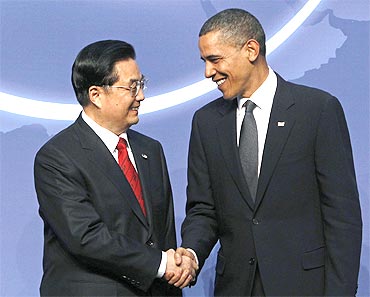



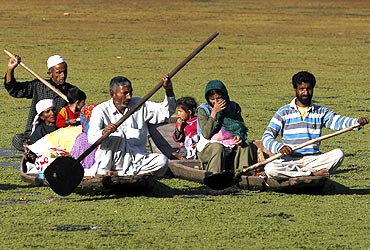
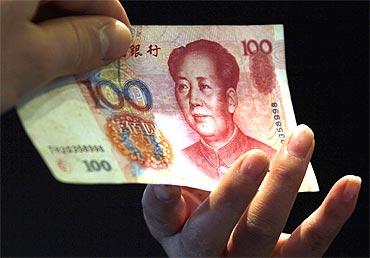

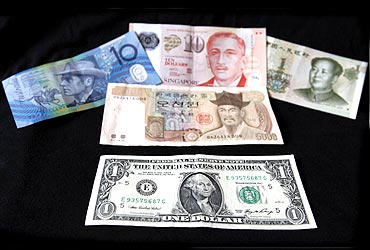
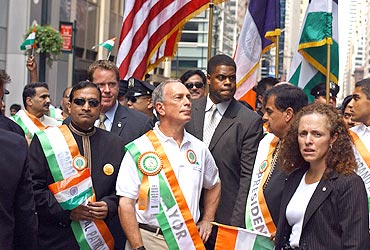
article